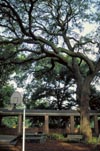Home >
Quercus geminata, Sand Live Oak
Best growth is made in moist, acid soil, sand, loam or clay, but the tree is amazingly adapted to drought. It also tolerates alkaline soil well. Construction-impacted trees take a long time to die, giving Sand Live Oak a reputation for being a tough tree. Once established, Sand Live Oak will thrive in almost any location and has very good wind and salt resistance. Sand Live Oak is a tough, enduring tree that will respond with vigorous growth to plentiful moisture on well-drained soil. Trees compartmentalize decay fairly well meaning that once injured, the tree has the ability slow or stop the spread of decay.
Like other Oaks, care must be taken to develop a strong branch structure early in the life of the tree. Q. geminata (Sand Live Oak) is more salt tolerant than Q. virginiana. Q. geminata tends to root sucker more than Q. virginiana.
Due to the coarse root system, the tree is often raised in fabric containers in field soil, is regularly root pruned in the field, or is grown in air root-pruning or copper root-pruning containers. The container systems allow for less circling roots along the edge of the root ball; the field systems may result in a greater portion of the root system harvested.
Oak wood is considered ring porous to semi-ring porous. Oaks serve as hosts for the gray hairstreak (Strymon melinus) butterfly.






